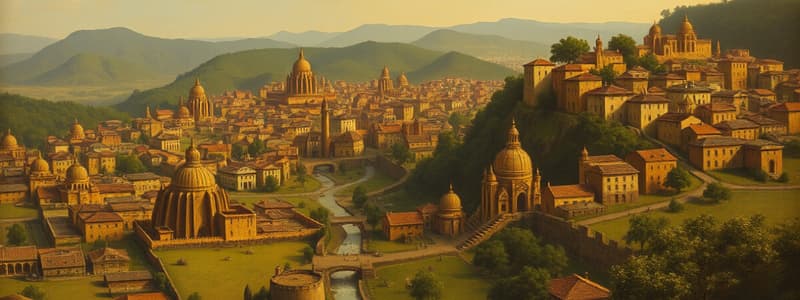Podcast
Questions and Answers
Which features characterized the urban planning of cities in the Indus Valley Civilization?
Which features characterized the urban planning of cities in the Indus Valley Civilization?
- Single-direction street layout
- Absence of public infrastructure
- Random layout of streets and buildings
- Use of standardized fired bricks for construction (correct)
What was a key component of the trade systems in the Indus Valley Civilization?
What was a key component of the trade systems in the Indus Valley Civilization?
- Mainly agricultural produce traded
- Exclusive reliance on land routes for trade
- Strict regulation limiting external trade
- Use of a barter system for goods exchange (correct)
What does the presence of figurines and seals in artifacts from the Indus Valley imply about their culture?
What does the presence of figurines and seals in artifacts from the Indus Valley imply about their culture?
- Strong religious significance attached to visuals (correct)
- Limited social interactions
- Focus solely on functional art
- A lack of artistic expression
What does the evidence of a merchant class in the Indus Valley Civilization indicate about its social structure?
What does the evidence of a merchant class in the Indus Valley Civilization indicate about its social structure?
What challenge exists in understanding the writing system of the Indus Valley Civilization?
What challenge exists in understanding the writing system of the Indus Valley Civilization?
Flashcards are hidden until you start studying
Study Notes
Indus Valley Civilization
Urban Planning
- Cities like Mohenjo-Daro and Harappa featured advanced urban planning.
- Grid layout with streets oriented north-south and east-west.
- Advanced drainage system with covered drains, public bathrooms, and wells.
- Use of standardized fired bricks for construction.
- Presence of public buildings, including granaries and warehouses.
Trade Systems
- Engaged in extensive trade with neighboring regions, including Mesopotamia.
- Used a barter system; goods traded included cotton, pottery, and metalwork.
- Evidence of weights and measures standardized for trade.
- Maritime trade routes through Arabian Sea for imports/exports.
- Trade goods included semi-precious stones and jewelry.
Art and Culture
- Notable for pottery, including painted and unpainted varieties.
- Sculpture and figurines made from terracotta and stone.
- Major religious symbols, perhaps linked to fertility rituals (e.g., Mother Goddess figurines).
- Seals with animal motifs and inscriptions, indicating artistic expression and possibly religious significance.
- Evidence of musical instruments, indicating a rich cultural life.
Social Structure
- Society likely stratified, though less rigid than contemporaneous civilizations.
- Evidence suggests a possible merchant class due to trade activities.
- Limited insight into political structure; possibly a theocratic or council-led governance.
- Gender roles inferred from artifacts; women depicted in various forms of art.
- Burial practices indicate some form of social inequality.
Writing System
- Developed a script, known as the Indus script, yet to be deciphered.
- Appeared on seals, pottery, and other artifacts.
- Composed of pictographs and symbols; over 400 distinct characters identified.
- Used for administrative and possibly religious purposes.
- Lack of bilingual inscriptions hinders understanding of the language and script.
Urban Planning
- Mohenjo-Daro and Harappa exemplified sophistication in urban design with planned layouts.
- City streets were arranged in a grid pattern, aligning north-south and east-west.
- Advanced drainage systems included covered drains, public facilities for bathing, and wells for water supply.
- Construction utilized standardized fired bricks, promoting uniformity and durability.
- Featured significant public structures such as granaries and warehouses for storage and distribution.
Trade Systems
- The civilization participated in extensive trade networks stretching to Mesopotamia.
- A barter system facilitated commerce, involving goods like cotton, pottery, and metalwork.
- Utilized standardized weights and measures for fair trade practices.
- Maritime routes across the Arabian Sea were crucial for imports and exports.
- Trade items included semi-precious stones and finely crafted jewelry, showcasing skilled artisanship.
Art and Culture
- Renowned for diverse pottery styles, both painted and plain, demonstrating artistic variety.
- Produced sculptures and figurines primarily from terracotta and stone, highlighting skill in craftsmanship.
- Artifacts, including Mother Goddess figurines, suggest connection to fertility and religious rituals.
- Seals adorned with animal motifs and inscriptions reflect both artistic creativity and potential religious significance.
- Evidence of musical instruments points to a vibrant cultural life with an emphasis on artistic pursuits.
Social Structure
- The society was likely stratified but less rigid compared to other ancient civilizations of the era.
- Indications of a merchant class emerged from extensive trade activities and commercial practices.
- Limited understanding of political organization suggests governance may have been theocratic or council-based.
- Gender roles inferred from artifacts indicate women were depicted in various artistic contexts.
- Burial customs hint at some level of social inequality within the community.
Writing System
- The Indus script, a yet undeciphered writing system, appeared on seals and various artifacts.
- Comprising pictographs and symbols, the script includes over 400 identified characters.
- Likely used for administrative functions and possibly for religious contexts as well.
- The absence of bilingual inscriptions complicates attempts to unravel the language and meaning of the script.
Studying That Suits You
Use AI to generate personalized quizzes and flashcards to suit your learning preferences.




